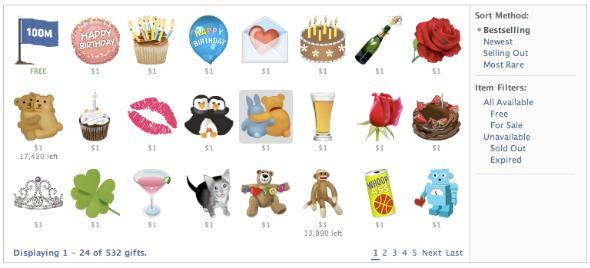Late last year, there was a rumor going around that Facebook expected to make up to $40 million from its virtual gifts feature in 2008. I never got that number confirmed. But in January, Jeremy Liew of Lightspeed Venture Partners analyzed the company’s gift sales and concluded that they would yield $15 million this year. Today, he’s revising that revenue number to be between $28 million and $43 million.
Facebook has seen a great increase in the number of gifts that its users are buying for each other, the study found. Between 390,000 and 600,000 gifts, priced at $1 a piece, were sold per week during the three-week study, with an average of around 470,000 purchases.
So, wherever the $40 million rumor came from, Liew’s study is the first good explanation of how it would actually be possible. We’ve been hearing success stories from third-party application creators since earlier this summer, with some apps, like Mob Wars, maybe making more than a million a month. This report gives credence to those numbers, too: Virtual goods are a good way for social networks and applications to make money. It also helps explain Lightspeed’s investments in third-party social networking companies that use virtual goods features, including Rock You and Friends for Sale.
AI Weekly
The must-read newsletter for AI and Big Data industry written by Khari Johnson, Kyle Wiggers, and Seth Colaner.
Included with VentureBeat Insider and VentureBeat VIP memberships.
Facebook introduced the gifts feature in February of 2007. A gift is simply an image of something, like a heart, a flower, or hundreds of other options, that when given, shows up on a “gift box” in a user’s profile. If the gift is public, then the recipients’ friends can see it, too. If it’s private, only the recipient and the giver can see it. To buy a gift, you can browse the “Gift Store,” which features the most popular items — along with a bunch of free ones, some of which are sponsored by advertisers.

Liew used the virtual gift store to calculate sales. There are limited numbers of gifts, despite the fact that they’re virtual — scarcity of virtual gifts leads to greater demand for them, presumably. You can see how many of each type of gift are left, as you’re in the process of buying one (see screenshot). By recording the decrease in number available of gifts available over a given period of time, Liew found how many of a particular kind of gift were sold over that period.
Now, there are all sorts of complications here, as Liew notes. In the course of the study, most top-selling gifts didn’t consistently show how many were still available. He also calculates in a surge in gift sales for the coming holiday season. Even with these caveats — for which Liew provides wide error margins — the overall uptick in gift sales is still obvious.
The bigger picture, anyway, is that this data helps explain why Facebook expects to possibly more than double its revenue from $150 million last year, to $350 million this year.
VentureBeat's mission is to be a digital town square for technical decision-makers to gain knowledge about transformative enterprise technology and transact. Learn More
